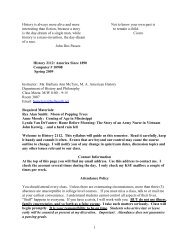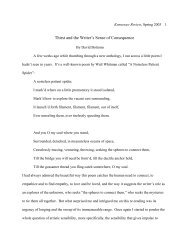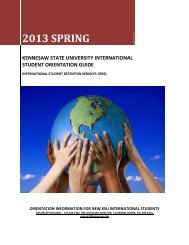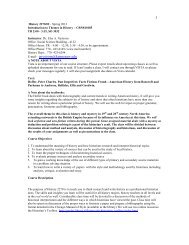Food, Gender and Cultural Hegemony - Kennesaw State University
Food, Gender and Cultural Hegemony - Kennesaw State University
Food, Gender and Cultural Hegemony - Kennesaw State University
Create successful ePaper yourself
Turn your PDF publications into a flip-book with our unique Google optimized e-Paper software.
Cualli 143<br />
nuns of Puebla invented Mole in honor of Viceroy Tomas Antonio de la Cerda y<br />
Aragon. Possibly the nuns, (influenced by the aristocratic Nahua girls being<br />
schooled in the convent), <strong>and</strong> in search of a dish that would be appropriately<br />
luxurious <strong>and</strong> stately for the Viceroy, came up with an elaboration of the most<br />
celebratory food that Nahua culture had to offer: the mole poblana. We know it<br />
was celebratory because it was featured as part of the marriage feast in the Codex<br />
Mendoza. The chocolate as an ingredient made it appropriate for royalty (there is<br />
no clear evidence if chocolate was part of the mole prior to the conquest).<br />
However, the inclusion of European spices such as cori<strong>and</strong>er, cloves,<br />
cinnamon <strong>and</strong> ginger made the mole familiar to the Spanish Viceroy. Jeffrey<br />
Pilcher remarks: "For mole poblano to have gained social status in colonial<br />
Mexico…it would have been seen as a Creole rather than mestizo dish. And<br />
notwithst<strong>and</strong>ing the New World chiles lurking inside, mole would have seemed<br />
completely appropriate for any medieval banquet," (Pilcher 42-43).<br />
The mole had to appear as a Creole creation, since the "mestizo" was essentially<br />
without social status in the colonial period. The genius of mole was that it had<br />
crucial indigenous characteristics as a cuisine, <strong>and</strong> was also credible as European<br />
cuisine.<br />
Conclusion<br />
This examination of food <strong>and</strong> identity in the conquest period in Mexico<br />
suggests that several factors were responsible for the successful creation of a<br />
creole cuisine that incorporated indigenous <strong>and</strong> Spanish foods. Similarities in<br />
modes of food preparation, an attitude of celebration <strong>and</strong> reverence toward food,<br />
<strong>and</strong> a relationship between social hierarchy <strong>and</strong> appropriate celebratory foods were<br />
all important in the evolution of a hybrid cuisine that would be seen as "national"<br />
by all groups. The influence of miscegenation <strong>and</strong> specifically the gradual<br />
infiltration of indigenous women through marriage <strong>and</strong> concubinage into Spanish<br />
society undoubtedly also were significant. The marriage of the tortilla with<br />
chicken <strong>and</strong> pork, combined with chiles <strong>and</strong> cheese; the knowledge to blend the<br />
flavors of chiles <strong>and</strong> spices on the metate; these factors resulted in a most<br />
[Type text]
















